| |
How
will you standout in this CROWD
during the Football Combines?
... It's not easy ... to get noticed
during the Combines. There are so many athletes. But it's the only chance
most football athletes will get to be seen by college and pro coaches.
The
photo above is what's it's like to compete for a college scholarship
or an NFL contract. You will be one of many. Know this before you begin
to prepare for the Combines because you'll need at least three months
of preparation to peak the day of the Combines.
How
do athletes get noticed?
First,
you must have documented superior performance in high school and you
better have grades. College coaches are measured by how many athletes
they graduate, and they simply won't waste a scholarship on someone
who shows laziness in the classroom.
Second,
you need a great 40 time. Look at the photo above and tell me how a
coach can spot the best athletes from this large group at the Combines.
It's simple, they can't. They look at the 40 time after-the-fact, and
start from there.
Everyone on this field is big, strong, and they are all the superstars
on their team. No matter what position, your 40 time is critical in
getting you noticed.
Don't
be mislead,
lifting is important, but there are thousands of guys who can bench
400 lbs and can't do anything on the field. And in 2008, the Nike Combines
completely eliminated the bench press test.
Vertical
jump is important for receivers, but there are lots of guys who can
jump that can't play football. And that's why your 40 must be fast.
You'll never get the opportunity to show a coach your football skills
until your 40 is fast. And your 5-10-5 or Pro- shuttle needs to be fast
to verify your 40 time.
Speed
is a skill and can be improved
Speed
is not just genetics, as once thought. It has been scientifically proven
numerous times that everyone can learn how to increase their speed,
quickness and agility. Many superstar athletes use speed coaches.
In
a formal study, researchers investigated what Combine tests predict
success in D1 college football. They concluded in Physical
Characteristics That Predict Functional Performance in Division I College
Football Players:
Strength
and conditioning professionals who work with collegiate football
players focus much of their time and effort on developing programs
to enhance athletic performance. Although there has been much speculation,
there is little scientific evidence to suggest which combination
of physical characteristics best predicts athletic performance in
this population. The purpose of this investigation was to examine
the relationship among 6 physical characteristics and 3 functional
measures in college football players. Data were gathered on 46 NCAA
Division I college football players. The 3 response variables were
36.6-m sprint, 18.3-m shuttle run, and vertical jump. The 6 regressor
variables were height, weight, percentage of body fat, hamstring
length, bench press, and hang clean. A stepwise multiple regression
analysis was performed to screen for variables that predict physical
performance. Regression analysis revealed clear prediction models
for the 36.6-m (40 yards) sprint and 18.3-m (5-10-5) shuttle run.
The results of this investigation will help strength and conditioning
specialists better understand the variables that predict athletic
performance in Division I college football players. (Davis,
2004, Journal of Strength and Conditioning Research: Vol. 18, No.
1, pp. 115–12)
If
you're serious
about playing at the next level, you need the 40
Speed Combines Prep Course. Train with Phil Campbell in Jackson, TN
or Menlo Park, CA, or get a group of 5 or more athletes to fly him in
to your location. You'll spend one morning in speed training followed
by upper-body explosive strength training. The next morning will be
speed training on the track followed by lower-body explosive strength
training so you'll know how to train to be at peak performance on the
day of your Combines, and during the season.
|
Check
for openings,call Kathy
408 363-4040
|
Why
are athletes from all over the US, and a sprinter from as far
away as the Netherlands coming to TN for speed training? One reason,
Results!
What's
the Secret?
... Our Training Principles
Key
principle of Phil Campbell's training is simple; you
can't train the body to move faster by training slow.
It's simple long slow running trains the body to run slow. One
more time: Slow running teaches your body
to be slow! 40 Speed training uses overspeed training
to reprogram the body and the brain to move faster.
Muscles
adapt.
The research is clear, muscles adapt to the way they are
trained - if you'll train fast, you'll get faster. If you train
slow; well... you know the results.
Important
questions for you.
If you lift heavy with the traditional slow tempo of
up-on-two and down-on-four ... how does your muscle adapt? That's
right, you get strong ... but slow. And this is fine for bench
press contests and bodybuilding, but it's not going to help
you much for sports requiring running speed and explosive movements.
If
you lift with heavy intensity (amount of resistance and the
velocity of movement) by using the 40 Speed E-lifts (Explosive
lifting techniques designed to recruit your fast-muscle fiber),
how will your muscle adapt? Exactly ... you'll build fast-twitch
fiber that's strong ... and fast.
Adam
November (below) used the 40 Speed E-lifts program during
the summer and jumped his bench press max from 400 to 450 lbs
(37 reps with 225 lbs). And he clocked in at an amazing 4.49
not to mention his record breaking 4.05 in the pro- shuttle
5-10-5. This is amazing because he weights 228 lbs.
|
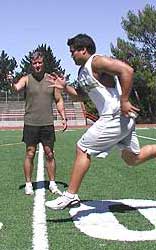
Will Ta'ufo'ou in high school.
Today, NFL with the Chicago Bears
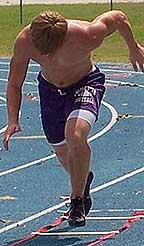
Chris Hohl, (4.39)
Father Ryan HS, Nashville, football & track athlete practicing technique
for explosive starts. SIGNED.
|
Nike
Combines
change
core strength measurement
The
Combines bench press test (how many reps an athlete can do with
185 pounds) is out of the line up Nike Combines. Bench press
is replaced with a 6 pound power ball toss.
Many of the Football Camps offered by the head coach, (which
is the combines for that University) will continue keep the
bench press test, however, over time, most combines typically
change and follow the format of the Nike Combines.
Combine
Performance
Improvement training -
Call Kathy for openings
408 363-4040
|
|
|
| |
How
to Boost Competitive Performance
By
moving away from outdated training routines such as traditional weight
lifting for strength and selecting strength training specifically for
sports, it’s easier than you may think to boost performance to
previously unattainable levels. Long slow distance running only teaches
the body to run slow. Even endurance athletes are using sprinting workouts
to improve speed and endurance.
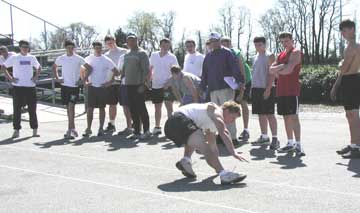
Coaches Craig Rogers and Jonathan West look on as D1 prospect,
Matt Hewett, and his Dresden, TN
teammates run the Pro-Shuttle (5-10-5) drill, one of the College and
Pro Combine tests.
In
a nutshell, 40 Speed.com will show you specific training methods that
have the most impact on sport performances by increasing speed, acceleration,
reaction, agility, and quickness.
Amazingly,
many new breakthroughs in sports speed take years before they become
widespread. Example: Scientific studies have shown that when individuals
train their arm muscles at a specific angle, they achieve major gains
in strength, but there are almost no improvements at other angles, even
though exactly the same arm muscles are involved. And this does not
help in most sports...well, arm wresting maybe.
When
athletes go to the gym, for example, they usually focus on the traditional
exercises that they’ve read about in magazines, and know how to
do. These include traditional bench presses and squats. These exercises
are great for developing general strength, but they won't help develop
speed unless explosive-lifting techniques are applied to strength training.
(If your school has a strength coach that uses explosive-lifts in sports
training, consider yourself very fortunate). Muscles adapt, and lifting
at the traditional tempo of up-on-two, down-on-four, will build strong
slow-twitch fiber, but it takes strong fast-twitch muscle fiber to score
touchdowns and win gold.
Basically,
squatting makes you a better squatter. In test after test, squats do
not help vertical jump. Squats build slow muscle fiber, which is positive
since that's 40% of your "muscles." Plyometric drills and
explosive lifting techniques build the fast (IIa) muscle fiber and the
super-fast (IIb or IIx) muscle fiber.
To
improve speed, specific exercises must be targeted at building all three
muscle fiber types. So the combination of explosive squats (or leg press)
followed by ten squat or lunge jumps with maximal effort do the job.
Plyometric drills, and super-fast agility ladder drills will make muscle
stronger and create the potential for significant gains in speed. This
type of work, within the context of speed technique training, will make
athletes faster.
|
Valdosta,
Georgia Lowndes County (Three time, 5A State Champions)
football athletes working on correct arm mechanics.
|
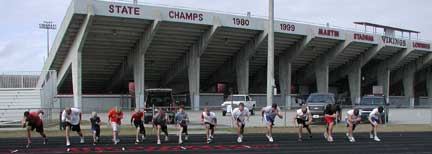
|
Rates
for Phil Campbell's COMBINES CRASH COURSE or his Speed /Strength training,
which includes basic and advanced speed techniques coupled with explosive
strength training techniques in Jackson, TN or at the Riekes Center
in Menlo
Park, CA $500 -- Individual training includes two 3 hour sessions
- one speed session followed by a strength session, on two mornings.Two
athletes = $375 each Three athletes = $300 each.
How to get in on the next Speed Camp
Call
Kathy for openings 408 363-4040
| |
|
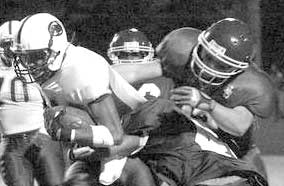
John Campbell, Junior LB - FB, North Side
Jackson, TN receives
Head Hunter Award for leading in tackles during the 2006 season,
2007 All State, All Region - McKenzie High School, 11th leading
tackler in state. SIGNED. |
|
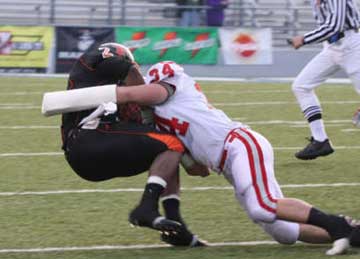 |
|
The
Truth about the 40
by
Phil Campbell, M.S., M.A., Certified American College of Sports
Medicine
The
40 yard sprint has no science behind it at all. Legendary coach,
Paul Brown, speculated that 40 yards was as long as a pro football
athlete would ever run during a game, and he began timing prospective
athletes in the 40. And the 40 was born. Today, the 40 has become
THE TEST of SPEED.
Right
or wrong, the 40 is The test of speed and it must be
mastered by athletes seeking to play at the next level.
Some
resistance speed training products advertise they have taken
athletes to the 4.1 and 4.2 performance levels. Here is the
truth. Ben Johnson is sprinter who ran the fastest 100 meter
sprint of all time and was disqualified for testing positive
for steroids before his record-breaking sprint. He covered his
first 40 yards in 4.26 seconds.
So
what's the probability of an athlete running faster the athlete
who ran the fastest sprint of all time (who was reportedly jacked-up
on steroids), wearing track spikes that weigh half of football
cleats, running not on grass, but a on a very fast track?
Are some coaches selling tickets with claims of great 40 times?
You be the judge. Devin Hester ran a 4.45 during the Miami Pro
day and ran a consistent 4.5 during the 2005 NFL Combines. Michael
Bennett ran a 4.13 during Pro Day at his school, and ran a 4.37
at the 2001 NFL Combines. Darrell Green and Bo Jackson co-own
the hand timed NFL record, at 4.22. And Deion Sanders is a close
second.
Of
the 12,000 athletes I have trained, I have only seen 30 or so
legitimate 4.3s. But in every case, every athlete coming for
speed training has left faster.
My speed technique training generally gets two tenths in technique
alone during the first speed session. The main goals for athletes
are to leave my two-day training camps knowing how to practice
perfect speed technique every time they run, and how to continue
their training to get faster and faster by building fast-twitch
muscle fiber and dynamic flexibility for the specific movements
of sprinting fast when they get home.
Combine
Performance
Improvement training -
Call Kathy for openings 408 363-4040
|
|
|
NFL
Bench Press Record
The NFL Combines uses number of reps with 225 pounds on bench
press. The bench press Combines record for NFL athletes is held
by Brigham Young offensive lineman, Scott Young, at 43 reps in
2005. Lineman Larry Allen did 43 reps at an NFL function in 2006.
Offensive lineman, Justin Geisinger, equaled 43 reps. It appears
that 44 reps will take the record.
|
|
Individual
& small group Training Rates
Rates
for Phil Campbell's SPEED CRASH COURSE or his Speed /Strength
training program, which includes basic and advanced speed techniques
coupled with explosive strength training techniques in Brookhaven,
MS or at the Riekes Center in Menlo Park, CA are:Three athletes
= $400 each -- Individual & small group training includes
two 2.5 hour sessions - one speed session followed by a strength
session, on two mornings.
Call
Kathy for openings
408 363-4040
Money
back guarantee! It's simple, if you don't improve speed
for your sport & you aren't 100% satisfied, payment will be
refunded.
Gift certificates available & credit cards accepted.
|
|
|

